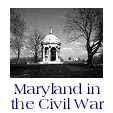
4th United States Colored Troops
Alternate Designations
History
The regiment was comprised of free men, recently freed slaves, and a number of slaves (those slaves living in the border states having not been freed by the Emancipation Proclamation) who were induced by recruiters to leave their masters.
Under pressure from General Robert C. Schenck, commander of the Middle Department and 8th Coprs, President Lincoln authorized the creation of black units in Maryland in June of 1863, provided the men were free when they enlisted. On June 13, 1863 the War Department authorized Colonel william birney of the 2nd U.S.C.T. to raise a regiment of free blacks in Maryland. Approxiamtely 1,002 men were enlisted and assembled at Camp birney in Baltimore. Apparently local slave owners were infuriated when Colonel Birney emptied Baltimore's jails and slave pens of the slaves who had been sent there to avoid military service.
Upon completion and organization of the regiment it was sent to Yorktown, Virginia for training, and remained there to build fortifications. Black soldiers were generaly considered inferior by most whites in the North, and they were often used to build fortifications, dig ditches, construct barracks and other manuel labor operations. The Confederate Army never drafted black soldiers, but some 35,000 black men served the Confederacy (not all freely - but many did). While Northerners failed to employ black soldiers in direct combat until late in the war, blacks fought for the Confederacy as early as the Battle of First Manassas. Also unlike their Northern counter parts, black soldiers in the Confederate Army received the same pay as their white peers.
Black soldiers had to over come numerous obstacles in order to serve their country. They were often provided with inferior or out dated equipment, held in reserve or assigned to guard wagon trains when in the field, and utilized as mnanual labor.
In October the 4th joined the 11th Pennyslvania Cavalry, 1st Ney York Mounted Rifles, the 8th New York Artillery and the Pennsylvania Light Artillery on an expedition into Matthew's County, virginia to destroy the "Confederate Volunteer Coast Guard." A total of 150 boats were destroyed and 80 beef cattle captured. Brigadier General I. J. Wistar remarked of the 4th "On two days they marched 30 miles a day without a straggler, or a complaint, and were ready for picket, patrol, or detachemtn duty at night." He added that "their discipline, obediance, and cheerfulness, for new troops, is surprising, and has dispelled many of my prejudices."
In February of 1864 the 4th U.S.C.T. participated in a Federal raid towards Richmond. Their greatest enemy during the raid was the inclement weather, snow and sleet.
In March the regiment was detailed to guard duty at Point Lookout Prison, St. Mary's County, Maryland.
In April the 4th was transferred to Fortress Monroe, Virginia, and from there transfered to General Butler's Army of the James. Friend of Abraham Lincoln, a previous governor of Massachusettes, and the man who had occuppied Baltimoire without orders in 1861, Butler was a firm believer in the ability of the black man to soldier. Butler had organized an entire division of black troops.
The regiment participated in the capture of City Point, Virginia and the initial demonstrations against Petersburg in May and June of 1864. The 4th was then assigned to the 18th Coprs, ordered to Bermuda Hundred, and participated in the battles of Spring Hill and Jordan's Farm.
In August it was back to manual labor, of a most deadly kind, when the regiment was assigned to help dig the Dutch Gap Canal. Workers were out in the open and under constant fire.
In September the 4th U.S.C.T. proceeded to Deep Bottom. On the 29th and 30th, along with eleven other U.S.C.T. regiments and the 2nd U.S. Colored Cavalry, the regiment participated in the capture of Fort Harrison. the attack was lauded by General Grant.
In December General Butler was given the tasks of taking Fort Fisher and the 4th U.S.C.T. participated in the failed expedition. A second campaign in January by General Alfred Terry was succesful in capturing the fort. The 4th particpated in the capture of Fort Fisher and the subsequent campaing along the North Carolina coast that followed, seeing action at Sugar Loaf Hill, the capture of Wilmington, Goldsboro and Raliegh.
The regiment continued on garrison duty in the south until mustered out of service May 4, 1866.
The regiment lost 3 commissioned officers and 102 men killed in battle, 1 officer and 186 men to disease. A total of four Medal of Honors was awarded to the unit, one to a white officer and three to enlisted men, including Sergeant Major Chrtistian Fleetwood. During the attack on Fort Harrison eleven of the twelve men assigned to the regimental color guard were killed or wounded, including two color bearers. Flleetwood seized up the fallen colors and "bore them nobly through the fight."
History provided by Gary Baker of the Association of Carroll's Sacred Trust.
Published Sources
James H. Whyte, "Maryland's Negro Regiments - How, Where they Served," Civil War Times Illustrated, (July 1962).
Archival Sources
Reenacting Links
Something missing?
Suggestions of additional resources welcomed! Please send info to John Lamb .






